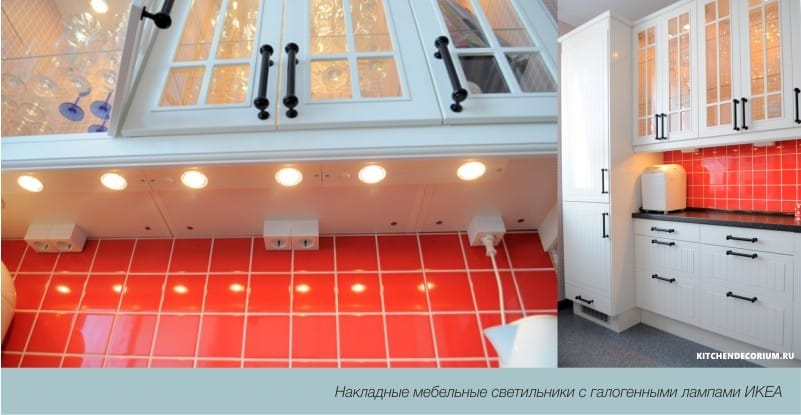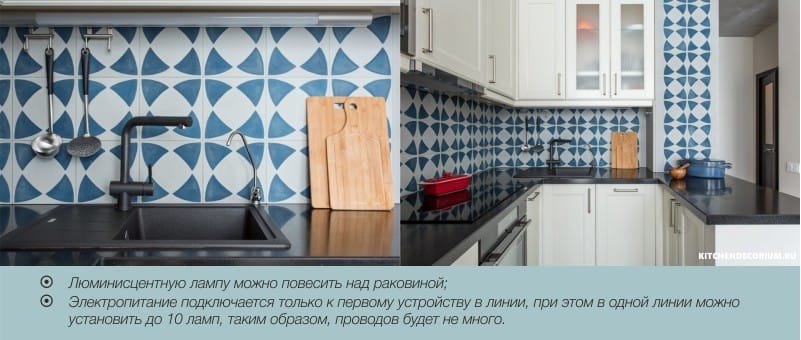Mortise lamps function as additional lighting, and also play the role of expressive decor in any design.
What types of furniture lighting for the kitchen are?


- Mortise (recessed) - designed for interior lighting cabinets, drawers, dressers, cupboards, as well as to illuminate the working surface. Requires preliminary planning and installation at the stage kitchen assembly.
- Overhead, which are mounted on external furniture facades. They are equipped with a turning mechanism and can illuminate both the inside of the headset and the tabletop. Among the advantages of such structures - ease of installation.

Furniture fixtures differ in the method of connection, which is divided into contact and non-contact. The first involves the use of a separate switch located, and the contactless is activated by itself when you open the door of the cabinet or just come to the countertop (this method is considered more economical).
Types of lamps for furniture fixtures
Furniture lamps can be equipped with the following types of lamps:
- Incandescent bulbs are inexpensive and familiar to everyone, they shine brightly. However, such mortise lamps should be placed at a great depth - over 70 mm, and they also get very hot during operation;
- Halogen lamps can be used much longer - about 4000 hours, they guarantee the brightness of the light and the minimum energy consumption;

They are also heated when used, but have a heat-resistant casing, so they can be placed anywhere. For the installation of lamps with halogen lamps, a transformer is required to convert the standard 220 watts to the required 12 watts.
- Xenon lamps heat up slightly, but generate too bright light output - for a small kitchen space, it may be too intense;
- Fluorescent lamps have a long service life - at least 6000 hours. Luminescent light can be not only cold, but also warm. Such lamps contain mercury. They are safe to use, but require special disposal, and therefore they are not thrown into ordinary garbage cans;

Keep in mind that the longer the lamp, the brighter the light it gives, that is, instead of 2 short lamps it is better to take one long one.
On sale there are special "kitchen" models with rails as in the photo below.

- LED lamps - absolutely do not contain harmful substances in the composition and consume a minimum of electricity. They also do not flicker when working and do not emit ultraviolet light. Indeed, their purchase may seem expensive, but in operation they fully justify the money spent.

In addition, the assortment, color and size range of LED furniture lights is very, very wide.In the kitchen you can install: LED strips, spot overhead and mortise fixtures, as well as linear ones, as in the photo below.

With the help of dimmers and rheostats, one can qualitatively adjust the intensity of the luminous flux and thus save on electricity.
Furniture Lighting Design
Furniture lighting is necessary in the kitchen not only to make the cooking process convenient, but also to decorate the kitchen. Furniture lighting, wherever it is placed, complements the ceiling lighting, making it even and soft, as the harsh shadows that it creates central chandeliergetting smaller.


Overhead or recessed fixtures of the yellow spectrum without the inclusion of ceiling light in the kitchen can create a very pleasant and cozy atmosphere.

The maximum white light close to the light of the white spectrum.

Illumination of the top of the kitchen unit and the directional light on the ceiling will visually make the low kitchen higher.

LED strip mounted on the bottom of the kitchen, create the effect of floating furniture.


Creating lighting with furniture lights
Kitchen furniture fixtures allow you to perform various types of lighting:
- Point, when the rays are not scattered, and is directed exclusively to the countertop, shelf, slab;

- Accent - here mortise fixtures are used that “sink” into the surface. It turns out the light that can give the space a special atmosphere, depth;


- Decorative - color furniture lamps are selected for it, the shade of which is aimed at stress relief.

The best choice for the kitchen - LED fluorescent lights.
However, for the kitchen, you can use several types of lamps, the installation of which will allow you to create a well-lit multi-functional space.
How to install and connect lamps
First of all, you need to decide on the design of the device, and then - calculate their required number. Overhead structures are fastened directly to the furniture using fasteners, which are included in the kit.

But with dotted built-in models of work a little more. So, for the work required:

- Measuring tape or ruler for measuring;
- Pencil or marker to mark up in the right places;
- Electric drill;
- Crowns for a drill from metal by means of which openings in the right places of furniture are carried out;
- Screwdriver;
- A sharp knife or side cutters needed to strip the wires.
As for the work, they are carried out in the following sequence:
- On the furniture in the right places put the markup.
- With the help of a drill with nozzles, crowns cut holes that match the size of the lamp. Important! The diameter of the crown must fully coincide with the size of the inside of the selected model of the lighting device.
- The device is connected to the electrical network. To do this, the ends of the wires are stripped and connected to the terminals. After that, the clamping screws are fastened as tightly as possible.
- The lamp is placed in a previously prepared hole. During installation, the spring should be fastened as much as possible to the body. In this case, the mounting springs automatically straighten, pressing the device to the furniture.
- The lamp is screwed into the installed device.
All work on the connection should be carried out only when the network is de-energized - this ensures your safety.
- LED lights for the kitchen from A to Z
- Everything about spot lighting in the kitchen
- DIY lamp for the kitchen - 3 ways and design ideas based on them
- The choice of lighting for kitchen cabinets and not only
- Sconces in the kitchen - playing with the light according to the rules


